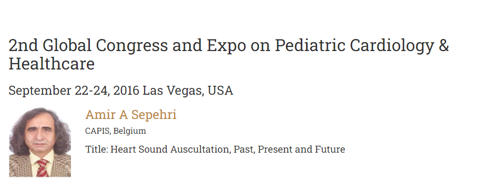Heart sound auscultation has been used as a screening technique for investigating cardiac conditions for over a thousand years. There is evidence showing that this technique was used during ancient Persian and Egyptian civilizations to verify heart condition but, the biggest breakthrough came in 1816 when the French physician, René Laennec, invented the first stethoscope by curving a wooden cylinder.
After the invention of the stethoscope, many diagnostic features of this technique were understood by the physicians and later, the phonocardiography became an important tool for cardiac diagnosis in the 1950s. This tool provides a plot of heart sound recording on a rolling paper.
However, after the creation of cardiac ultrasound imaging in Lund, Sweden, phonocardiography became less appreciated by cardiologists due to the informative graphical representation, provided by echocardiography, which is still recommended by the pertinent associations as the tool with a central role in diagnosis.
In Doppler echocardiography, disease diagnosis is based on the direct and indirect measurement and calculation of the operator. This attributes a subjectivity to the approach, even though it has been objectively accepted by the cardiology community, which is considered a drawback of the approach that limits its application to expert clinicians, and access to such expert clinicians is not easy, especially in rural places. Heart sound auscultation is, therefore, employed in all medical settings as the first screening approach, which is by far a less expensive method.
Due to the progress in signal processing and artificial intelligence, many studies aimed to associate intelligence with the heart sound auscultation technique in order to improve screening accuracy in cardiac auscultation especially, in children, where the accuracy is substantially impaired by innocent murmurs. A study at Johns Hopkins University, USA, showed that the screening accuracy in pediatric cases is as low as 40% in family doctors, which can be rather improved by using computer-assisted auscultation.
Our previous study revealed that the development of an automated tool for screening congenital heart disease in children is achievable by using our unique processing method, named Arash-Band, which has been internationally patented. Such a processing method was incorporated into the appropriate graphical user interface and installed on a portable processing unit, to be employed by the practitioners or nurses in primary healthcare centers for improved screening.
This automated system, which we called digital phonocardiograph, was tested by a trained layman operator over a large number of volunteers from nursery and elementary schools and, also from a referral hospital, and the results showed great compliance of more than 90% with the echocardiography. Our proposed digital phonocardiograph is now available on the market. One of the interesting capabilities of the system is its discrimination power in separating innocent murmurs from pathological ones and hence offers low values for both positive and negative errors.
Further efforts have been made to lift the applicability of the digital phonocardiograph from screening to diagnosis by adding intelligent algorithms for disease detection. In a study, we concluded that the digital phonocardiograph is capable to detect children with bicuspid aortic valves. Further studies toward disease diagnosis i.e. aortic stenosis, showed promising results for commercialization.
The Arash-Band method is easily implementable on smartphones and web technology, which will result in a homecare system for pediatric heart disease screening. It is implied that the digital phonocardiograph tends to provide rather diagnostic information in the future and avails echocardiography to those in need, where the decision for an appropriate therapy is critical.



